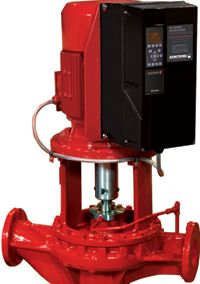Migrating from a constant speed system to variable speed pumping is easier today than it has ever been says Wayne Rose, marketing director of Armstrong.
IVS 'Sensorless pumps' (that react automatically to demand without the need for remotely mounted system feedback) are now available with variable speed drives up to 55 kW. This offers all of the benefits of variable speed pumping (such as lower energy consumption, better system performance, enhanced Building Regulations compliance, longer equipment life and reduced noise) without the complexity.
The pumping technology is only one factor in a successful upgrade however. Equally important (but frequently overlooked) are the adaptations needed to convert the system for variable speed operation.
Without careful consideration of the flow system, there is the risk that energy savings gained through investment in new plant will be lost because the full potential of the part-load environment is not being maximised.
For example, with 3-way valves installed, there is no opportunity to reduce the pump flow, as the valve will divert flow as demand is reduced. This results in constant pump flow, even though the pump is equipped to deliver more efficient part-load pumping.
So how can the system be converted effectively?
Conversion options
One solution is to close the bypass line valve, so that the 3-way valves effectively become 2-way valves, as shown in Figure 1. With the bypass closed, when the 3-way valve modulates to attempt to divert the flow through the bypass, it will restrict the flow rate instead. An IVS pump (with on-board variable speed drive) will sense this deviation from its control curve and reduce speed until the pre-set control curve, the system resistance curve, and the pump performance curve at the new speed converge for the new operating point.

Armstrong 4300 IVS sensorless pump
This will reduce energy consumption, cutting the carbon impact of the pump and saving money. As the water velocity is lower, noise is reduced and, as the pump is not working at full capacity at all times, the time between repairs, and the lifecycle of the equipment, are extended Variable flow HVAC systems converted from 3-way control to 2-way control can experience certain challenges when all the 2-way valves are shut off however.
For example, the pumps may overheat if they continue to run against closed valves at their minimum speed. Or the temperature of the conditioned water in the headers and remote risers, now stationary, will decay to ambient, leading to a delay in delivering freshly heated or cooled water from the plant room, up the riser, and along the floor to the terminal.
One simple solution we recommend is to leave open the most remote 3-way valve bypass line on each riser as shown in Figure 2. If there are few loads in the zone, close the most remote 3-way valve by 50 per cent so that energy is not wasted with too much conditioned water being returned unused to the chiller or boiler. In this way, water will only be bypassed when the remote load (typically the least served in the system) is satisfied.
Another effective bypass control option would be to mount a differential pressure sensor on the index circuit, with a pressure actuated bypass valve installed in the plant room.
The pressure will be constant at the remote point and will vary closer to the pump in the plant room.
As the loads vary, the pump speed will adjust to match the DP setting and the actual friction loss in the distribution piping. Normally closed, the pressure actuated bypass valve will sense a fall in differential pressure in a part load situation and open, allowing a minimum flow through the pump.
While being simple to install, it does not provide the minimum flow needed to keep the water in the distribution piping at the operating temperature.
Fan coil solutions
Modern fan coils units may be fitted with 4-way control valves providing an internal bypass of chilled water from the supply to the return line. Converting these valves to 2-way is not simple as it involves getting access to each of the FCUs (of which there may be many) and changing out the valves
manually.
A more effective solution is to leave the FCUs in place and use pump technology to control the return temperature. When the FCU is operating on bypass, the water leaves the FCU at the same temperature that it enters, no heat is supplied into or taken from the conditioned space as the temperature setting has been reached.
This means the pumps can be controlled by measuring the return temperature and can reduce the flow rate/operating speed until the return temperature is back within design range. To prevent the risk of underpumping in some zones while others are satisfied, multiple sensors need to be applied to return pipework around the building. The Armstrong IPS system can currently control pumps in systems with up to 18 zones for applications such as this.
These are just some of the control options. Others are outlined in Armtrong's technical white paper
Conversion from constant flow system to variable flow.
The paper provides further guidance, covering the best ways of upgrading for ac systems, radiators and primary pumping, and includes a number of additional ideas for bypass control.
It is available by emailing
LSullivan@armlink.com.